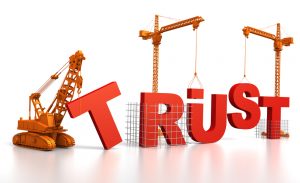 Trust is an essential component in any channel of the communication process within any organization. With trust prevalent in the atmosphere of any organization, subordinates place their confidence in the ability of managers to lead effectively and with integrity. Herein lies the fundamental challenge facing any organization: how do managers build and sustain a widespread climate of trust?
Trust is an essential component in any channel of the communication process within any organization. With trust prevalent in the atmosphere of any organization, subordinates place their confidence in the ability of managers to lead effectively and with integrity. Herein lies the fundamental challenge facing any organization: how do managers build and sustain a widespread climate of trust?
As goes the wisdom of the famous investor Warren Buffet, “It takes twenty years to build a reputation and five minutes to ruin it. If you think about that , you’ll do things differently“. Trust and reputation are not a given in any organization; they take an incredible amount of dedication and persistence to build. In my opinion, the starting point for any manager looking to bolster the integrity of an organization is to establish rich communication channels – that is, make the means for communication in an organization ceaseless in their ability transfer meaning. This should take the form of face-to-face interactions, avoiding digital communication as much as possible. By sticking to rich communication channels, managers mitigate the possibilities of their meaning being distorted by communication barriers such as filtering, selective perception and silence, while the enhancing their communication by adding nonverbal gestures.
Furthermore, I believe another key to establishing trust within an organization lies within constructing effective and purposeful communication networks; as the meaning of communication can inevitably become distorted as it flows through the various levels of an organization, it is important to design communication channels that allow information to travel fluently from one source to another. In my opinion, all-channel networks are the most suitable for achieving the fluent transfer of information as they are proven not only to be efficient and effective in transfer, but also high in employee satisfaction. It is key however to emphasize that when managers communicate with their employees, they should aim to limit ambiguities and strive for coherence, as they should take an active role in informing subordinates about the state of knowledge within the organization.
Tags: #comm292 #blogproject
Word Count: 311
Bibliography:
Donahue, B. (2014, November 27). Trust [Image]. Retrieved from http://churchleaders.com/smallgroups/leading-small-group-leaders/150783-bill_donahue_trust_how_to_build_it_up_or_tear_it_down_in_your_group.html
The Role and Importance of Building Trust. (2008, February). Retrieved from PennState: Department of Agricultural Economics, Sociology and Education website: http://aese.psu.edu/research/centers/cecd/engagement-toolbox/role-importance-of-building-trust